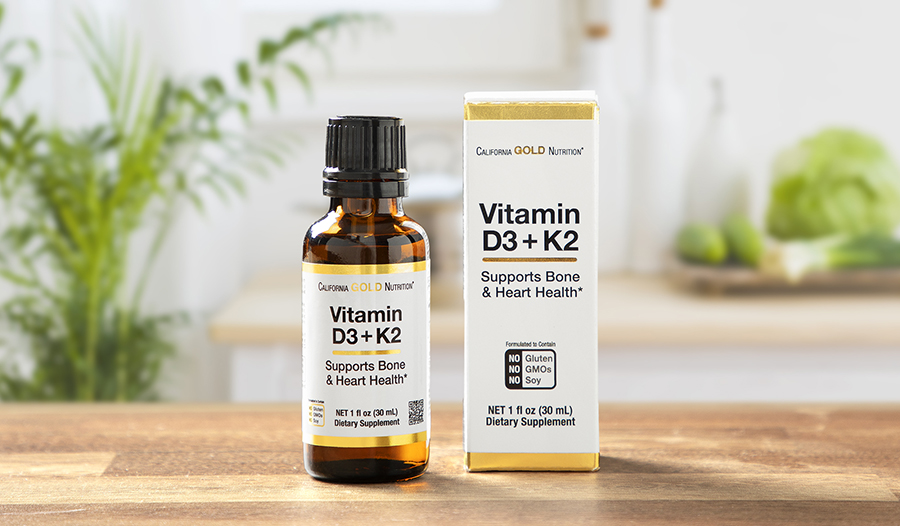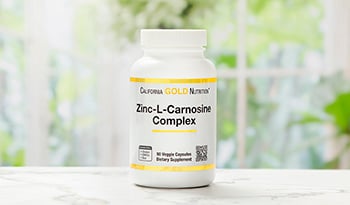5 Vitamin Duos That Work Better Together
DISCLAIMER:This blog does not intend to provide diagnosis...
- In this article:
- Vitamin D and Vitamin K
- Fish Oil and Vitamin E
- Folate and Vitamin B12
- Zinc and Copper
- Iron and Vitamin C
- Takeaway

In nature, the vitamins and minerals we need are almost never found in isolation. Foods typically contain a complex mix of macronutrients and micronutrients that all work together to provide what our bodies need to function optimally. Over time, as our understanding of nutrition has grown, we have isolated and identified the individual vitamins and minerals that our body needs to survive. This has made it possible to take large doses of single nutrients. However, certain nutrients function better when taken together rather than in isolation. Understanding how nutrients are utilized together can help maximize their benefits and minimize potential harms when supplementing specific nutrients.
Vitamin D and Vitamin K
Over the last 30 years, our understanding of vitamin D has exploded. While vitamin D was initially recognized as important for bone health, especially in children, the latest research shows a much more complex and nuanced understanding of the vitamin.
Vitamin D is crucial for calcium absorption. However, data strongly suggest that it also plays a significant role in heart health, autoimmune disease, neurological conditions, infections, pregnancy outcomes, and other chronic disease states. Research shows that adequate vitamin D helps to ward off infections while reining in excess inflammation. Recent reviews suggest that appropriate supplementation may help with diabetes and respiratory tract infections. Studies also suggest that appropriate vitamin D supplementation may help prevent or improve the progression of certain autoimmune conditions. Considering the often-devastating consequences of these diseases, it should come as no surprise that vitamin D supplementation is popular. Links with longevity have been suggested, but not proven.
Vitamin K, like vitamin D, has long been associated with a single function. Generally, vitamin K is thought of as the blood-clotting vitamin. Warfarin, one of the early blood thinners used for treating and preventing blood clots, works by inhibiting vitamin K. However, like vitamin D, our understanding of vitamin K continues to expand.
Recent data suggest that vitamin K helps strengthen bones, may help prevent hardening of the arteries related to heart disease, and may play a role in diabetes through improved insulin sensitivity. Vitamin K has a role in calcium metabolism, helping to keep calcium from building up and damaging blood vessels while redirecting it into bone to increase bone strength.
As such, vitamin D and vitamin K are interlinked. Vitamin D increases calcium absorption. When taken with adequate vitamin K, the absorbed calcium is directed into the appropriate locations throughout the body to maintain bone and blood vessel health.
Fish Oil and Vitamin E
Like vitamin D, fish oil is another popular supplement. Some of the latest research suggests that fish oil may help in the treatment of depression. Data also suggest that it may play a role in the prevention of dementia and heart disease. In general, fish oil has anti-inflammatory and blood-thinning effects throughout the body.
While fish oil appears to have benefits, there are challenges and concerns over the quality of fish oil supplements. Due to its chemical structure, fish oil can easily become rancid. Rancid fish oil has been shown to have negative effects in animal studies, which strongly suggests negative consequences for human consumption.
Vitamin E is a fat-soluble antioxidant that can protect against rancidity. A recent study on women found that long-term consumption of fish oil depletes vitamin E, increasing free radical activity throughout the bloodstream. While six international units (6 IU) of vitamin E were included in the study, it clearly wasn’t enough to prevent the increased free radicals seen with fish oil supplementation.
Because fish oil is easily damaged, it’s likely wise to include additional fat-soluble antioxidants with its consumption. Levels of vitamin E greater than 6 IU are likely needed to help protect fish oil from going rancid or causing free radical problems within the body.
Folate and Vitamin B12
Homocysteine is a toxic amino acid produced in the body that appears to increase the risks for dementia and heart disease. Vitamin B12 and folate are both needed to process homocysteine. When present in adequate amounts, they can effectively decrease homocysteine levels.
While the data for heart disease benefits from folate and vitamin B12 remain less clear, with respect to dementia, an international consensus statement in 2018 concluded that even moderate elevations of homocysteine in the elderly is a cause of cognitive decline and dementia. Further, the statement notes that the risks from elevated homocysteine should not be underestimated, especially because treating it with B vitamins, such as folate and vitamin B12, is cheap, safe, and effective. As such, these nutrients appear to have anti-aging benefits for the brain.
Vitamin B12 and folate are two B vitamins that function together in what is called the methylation cycle. The methylation cycle is a complex but critical system in the body. It plays a part in attaching methyl groups to different compounds. A methyl group is a carbon atom bonded to three hydrogens. Methyl groups are important for deoxyribonucleic acid (DNA), the production of neurotransmitters, the functioning of nerves, and other systems throughout the body. Homocysteine is naturally produced in the methylation cycle and is effectively reduced when folate and vitamin B12 are in good supply.
Deficiency of either vitamin B12 or folate can present similarly. If severe, a deficiency in either vitamin can cause permanent nerve damage. If a B12 deficiency is mistakenly treated with folate, it can mask the symptoms while underlying nerve damage continues to progress. Whenever supplementing with folate, it is always best to include vitamin B12 to prevent any risk of nerve damage from a vitamin B12 deficiency.
Zinc and Copper
Zinc and copper are two critical micronutrients. Zinc has multiple roles in the body, although its effects on immune function are often highlighted. Copper is important for antioxidant defenses and connective tissue formation among other functions. Both minerals can cause problems when deficient or when taken in excess. The two minerals also have a somewhat adversarial relationship with high copper often coinciding with low zinc and high zinc reducing copper levels.
Due to its immune system benefits, zinc is a common and popular nutritional supplement. Over-the-counter products containing 50 mg or more of zinc per pill are readily available. However, data from human studies have found that taking more than 50 mg of zinc per day in total from both supplements and food can cause copper deficiency. Symptoms of copper deficiency can be severe, including anemia and peripheral neuropathy, a form of nerve damage. If not caught early, this nerve damage can be permanent.
Whenever zinc is supplemented by more than 30 mg per day, copper should be included. Even at 30 mg per day, it is likely wise to consider adding a little copper unless a person’s diet is known to be high in the mineral. While copper excess can be a problem, it’s generally believed that copper supplementation of up to 10 mg per day poses minimal risks except in people with Wilson’s disease, a genetic condition that causes excess copper accumulation. However, some studies have suggested that dosing over 7 mg of copper per day might be excessive. Normal values for copper supplementation on a daily basis are usually between 500 micrograms and 2 mg per day.
Iron and Vitamin C
Iron is an important mineral for producing energy in the body. Iron is critical to the formation of hemoglobin. Hemoglobin is an iron-containing protein that carries oxygen inside your red blood cells. The red blood cells shuttle oxygen from the lungs to where it is needed in the tissues. Without iron, red blood cells cannot carry oxygen. If oxygen delivery to the cells and tissues begins to fail, energy production throughout the body can suffer. This can lead to anemia and fatigue.
Iron deficiency is common throughout the world, especially in women of child-bearing age. The menstrual cycle, causing monthly blood loss, decreases iron levels. Since iron isn’t well absorbed, it’s one of the more common nutritional deficiencies.
One of the simplest ways to increase iron absorption is by taking it with vitamin C. Vitamin C has been shown to enhance iron uptake from the gastrointestinal tract. However, the benefits of vitamin C on iron function do not stop with absorption. Vitamin C also plays a role in individual cellular uptake and iron storage. Because iron can also act as a free radical, having additional antioxidants, like vitamin C can help minimize any risks.
Takeaway
While many vitamin and mineral supplements are purchased individually and taken as standalone nutrients, it is worth being aware that some nutrients work better in combination. Several nutrient duos stand out, including vitamin D and vitamin K, fish oil and vitamin E, folate and vitamin B12, zinc and copper, and iron with vitamin C.
References:
- Amrein K, Scherkl M, Hoffmann M, et al. Vitamin D deficiency 2.0: an update on the current status worldwide. Eur J Clin Nutr. 2020;74(11):1498-1513. doi:10.1038/s41430-020-0558-y
- Bannenberg G, Mallon C, Edwards H, et al. Omega-3 long-chain polyunsaturated fatty acid content and oxidation state of fish oil supplements in New Zealand. Sci Rep. 2017;7(1):1488. Published 2017 May 3. doi:10.1038/s41598-017-01470-4
- DiNicolantonio JJ, Bhutani J, O'Keefe JH. The health benefits of vitamin K. Open Heart. 2015;2(1):e000300. Published 2015 Oct 6. doi:10.1136/openhrt-2015-000300
- Duncan A, Yacoubian C, Watson N, Morrison I. The risk of copper deficiency in patients prescribed zinc supplements. J Clin Pathol. 2015;68(9):723-725. doi:10.1136/jclinpath-2014-202837
- Ellulu MS, Khaza'ai H, Abed Y, Rahmat A, Ismail P, Ranneh Y. Role of fish oil in human health and possible mechanism to reduce the inflammation. Inflammopharmacology. 2015;23(2-3):79-89. doi:10.1007/s10787-015-0228-1
- Froese DS, Fowler B, Baumgartner MR. Vitamin B12, folate, and the methionine remethylation cycle-biochemistry, pathways, and regulation. J Inherit Metab Dis. 2019;42(4):673-685. doi:10.1002/jimd.12009
- Gröber U, Reichrath J, Holick MF, Kisters K. Vitamin K: an old vitamin in a new perspective. Dermatoendocrinol. 2015;6(1):e968490. Published 2015 Jan 21. doi:10.4161/19381972.2014.968490
- Hojyo S, Fukada T. Roles of zinc signaling in the immune system. J Immunol Res. 2016;2016:6762343. doi:10.1155/2016/6762343
- Illescas-Montes R, Melguizo-Rodríguez L, Ruiz C, Costela-Ruiz VJ. Vitamin D and autoimmune diseases. Life Sci. 2019;233:116744. doi:10.1016/j.lfs.2019.116744
- Jiang L, Wang J, Xiong K, Xu L, Zhang B, Ma A. Intake of fish and marine n-3 polyunsaturated fatty acids and risk of cardiovascular disease mortality: a meta-analysis of prospective cohort studies. Nutrients. 2021;13(7):2342. Published 2021 Jul 9. doi:10.3390/nu13072342
- Lane DJ, Richardson DR. The active role of vitamin C in mammalian iron metabolism: much more than just enhanced iron absorption!. Free Radic Biol Med. 2014;75:69-83. doi:10.1016/j.freeradbiomed.2014.07.007
- Martineau AR, Jolliffe DA, Hooper RL, et al. Vitamin D supplementation to prevent acute respiratory tract infections: systematic review and meta-analysis of individual participant data. BMJ. 2017;356:i6583. Published 2017 Feb 15. doi:10.1136/bmj.i6583
- Mason RP, Sherratt SCR. Omega-3 fatty acid fish oil dietary supplements contain saturated fats and oxidized lipids that may interfere with their intended biological benefits. Biochem Biophys Res Commun. 2017;483(1):425-429. doi:10.1016/j.bbrc.2016.12.127
- Miller AL. The methylation, neurotransmitter, and antioxidant connections between folate and depression. Altern Med Rev. 2008;13(3):216-226.
- Papanikolaou G, Pantopoulos K. Iron metabolism and toxicity. Toxicol Appl Pharmacol. 2005;202(2):199-211. doi:10.1016/j.taap.2004.06.021
- Pérez-López FR, Fernández-Alonso AM, Mannella P, Chedraui P. Vitamin D, sunlight and longevity. Minerva Endocrinol. 2011;36(3):257-266.
- Phung AS, Bannenberg G, Vigor C, et al. Chemical compositional changes in over-oxidized fish oils. Foods. 2020;9(10):1501. Published 2020 Oct 20. doi:10.3390/foods9101501
- Pilz S, Zittermann A, Trummer C, et al. Vitamin D testing and treatment: a narrative review of current evidence. Endocr Connect. 2019;8(2):R27-R43. doi:10.1530/EC-18-0432
- Prohaska JR. Impact of copper deficiency in humans. Ann N Y Acad Sci. 2014;1314:1-5. doi:10.1111/nyas.12354
- Scott JM, Weir DG. Folic acid, homocysteine and one-carbon metabolism: a review of the essential biochemistry. J Cardiovasc Risk. 1998;5(4):223-227.
- Shane B, Stokstad EL. Vitamin B12-folate interrelationships. Annu Rev Nutr. 1985;5:115-141. doi:10.1146/annurev.nu.05.070185.000555
- Smith AD, Refsum H, Bottiglieri T, et al. Homocysteine and dementia: an international consensus statement. J Alzheimers Dis. 2018;62(2):561-570. doi:10.3233/JAD-171042
- Stern BR, Solioz M, Krewski D, et al. Copper and human health: biochemistry, genetics, and strategies for modeling dose-response relationships. J Toxicol Environ Health B Crit Rev. 2007;10(3):157-222. doi:10.1080/10937400600755911
- Turnlund JR, Jacob RA, Keen CL, et al. Long-term high copper intake: effects on indexes of copper status, antioxidant status, and immune function in young men. Am J Clin Nutr. 2004;79(6):1037-1044. doi:10.1093/ajcn/79.6.1037
- Wolters M, von der Haar A, Baalmann AK, Wellbrock M, Heise TL, Rach S. Effects of n-3 polyunsaturated fatty acid supplementation in the prevention and treatment of depressive disorders-a systematic review and meta-analysis. Nutrients. 2021;13(4):1070. Published 2021 Mar 25. doi:10.3390/nu13041070
- Zhu RZ, Chen MQ, Zhang ZW, Wu TY, Zhao WH. Dietary fatty acids and risk for Alzheimer's disease, dementia, and mild cognitive impairment: a prospective cohort meta-analysis. Nutrition. 2021;90:111355. doi:10.1016/j.nut.2021.111355

 By Dr. Scott Buesing, N.D.
By Dr. Scott Buesing, N.D.


